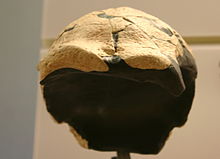Saldanha 1
Saldanha 1 is the scientific name for a fossilized skull roof of an adult person of the genus Homo , which was discovered on January 8, 1953 in Hopefield , Saldanha Bay municipality ( South Africa ). The fossil is dated on the basis of accompanying finds to the Middle Pleistocene , the age ascribed to it is given as 500,000 to 200,000 years. It was found in a fossil deposit on the farm Elandsfontein, which has been explored since 1951.
discovery
Saldanha 1 is a surface find that is also known in the English-speaking world as "Saldanha man" (Saldanha man), "Saldanha cranium" (Saldanha skull) and "Elandsfontein cranium". Ten fragments that were scattered over an area of around 1.5 m² but belonged together had been eroded out of sandy soil and picked up by Keith Jolly, then assistant to anatomy professor Matthew Robertson Drennan at the University of Cape Town . Later on, more fragments were found by Ronald Singer , who was also Drennen's assistant at the time, some of them at greater distance. However, due to their fit, they could be ascribed to the skull roof, so that it was ultimately reconstructed from 27 fragments. Because of this finding situation, dating has so far proved difficult and imprecise. It was suspected, however, that the hand axes and numerous other stone tools discovered at the same time were attributable to the relatives of the find.
features
The skull roof was first scientifically described in 1953 by Matthew R. Drennan, followed by a more detailed description in 1954. Accordingly, the skull bones are very thick with at least 13 millimeters, so that the brain volume was only 1200 to 1250 cm³ despite the size of the skull. It was also mentioned as a striking feature that the bulges above the eyes are more massive and more directed downwards than in the Neanderthals and are most comparable to the fossil skull Kabwe 1 (= Homo rhodesiensis ); In this context, it was noted by Ronald Singer in 1954 that Saldanha 1 is evidence that Kabwe 1 is “not a single abnormal or pathological form of a primitive person”. Singer finally suspected that the differences between the two skulls were within the range of variation of related individuals and that both skulls could be interpreted as an African variant of a Neanderthal, which differs significantly from the European variant. Drennan, on the other hand, proposed a differentiation between Saldanha 1 and Kabwe 1 and in 1955 referred to the skull roof as Homo saldanensis . As early as 1957, both interpretations were rejected as too largely and both findings were placed in the vicinity of an archaic Homo sapiens .
In early 1955, the journal Nature announced the discovery of a lower jaw fragment that may have belonged to the same individual as the roof of the skull.
Tribal classification
Today the state of research is that the skull roof not only shares various morphological features with the skull Kabwe 1, but also with the skulls Bodo 1 from Ethiopia and Petralona 1 from Greece as well as with the Arago fossils from southern France . Correspondingly, some of the paleoanthropologists place it on Homo rhodesiensis , others on Homo heidelbergensis and occasionally also on the archaic Homo sapiens . However, all three variants assume that the skull roof is close to the early African ancestors of anatomically modern humans ( Homo sapiens ).
literature
- Neil C. Tappen: Studies on the condition and structure of bone of the Saldanha fossil cranium. In: American Journal of Physical Anthropology. Volume 50, No. 4, 1979, pp. 591-603, doi: 10.1002 / ajpa.1330500410
- Ronald Singer and John Wymer : Archaeological Investigations at the Saldanha Skull Site in South Africa. In: The South African Archaeological Bulletin. Volume 23, No. 91, 1968, pp. 63-74, doi: 10.2307 / 3888485
Individual evidence
- ↑ Entry Saldanha on humanorigins.si.edu , last accessed on May 6, 2019
- ^ A b Ronald Singer : The Saldanha Skull from Hopefield, South Africa . In: American Journal of Physical Anthropology. Volume 12, No. 3, 1954, pp. 345–62, doi: 10.1002 / ajpa.1330120309 , full text (PDF)
-
^ Matthew R. Drennan: A preliminary note on the Saldanha skull. In: South African Journal of Science. Volume 50, No. 1, 1953, pp. 7-11.
Matthew R. Drennan: The Saldanha skull and its associations. In: Nature . Volume 172, 1953, pp. 791-793, doi: 10.1038 / 172791a0 - ^ Matthew R. Drennan: Saldanha Man and his associations. In: American Anthropologist. Volume 56, No. 5, 1954, pp. 879-884, doi: 10.1525 / aa.1954.56.5.02a00150 , full text
- ^ Matthew R. Drennan: The special features and status of the Saldanha skull. In: American Journal of Physical Anthropology. Volume 13, No. 4, 1955, pp. 625-634, doi: 10.1002 / ajpa.1330130406 , full text
- ^ William L. Straus Jr .: Saldanha Man and His Culture. In: Science . Volume 125, No. 3255, 1957, pp. 973-974, doi: 10.1126 / science.125.3255.973
- ^ Matthew R. Drennan and Ronald Singer: A Mandibular Fragment, Probably of the Saldanha Skull. In: Nature. Volume 175, 1955, pp. 364-365, doi: 10.1038 / 175364a0
- ^ Entry Saldanha 1 in: Bernard Wood : Wiley-Blackwell Encyclopedia of Human Evolution . Wiley-Blackwell, 2011, ISBN 978-1-4051-5510-6 .
